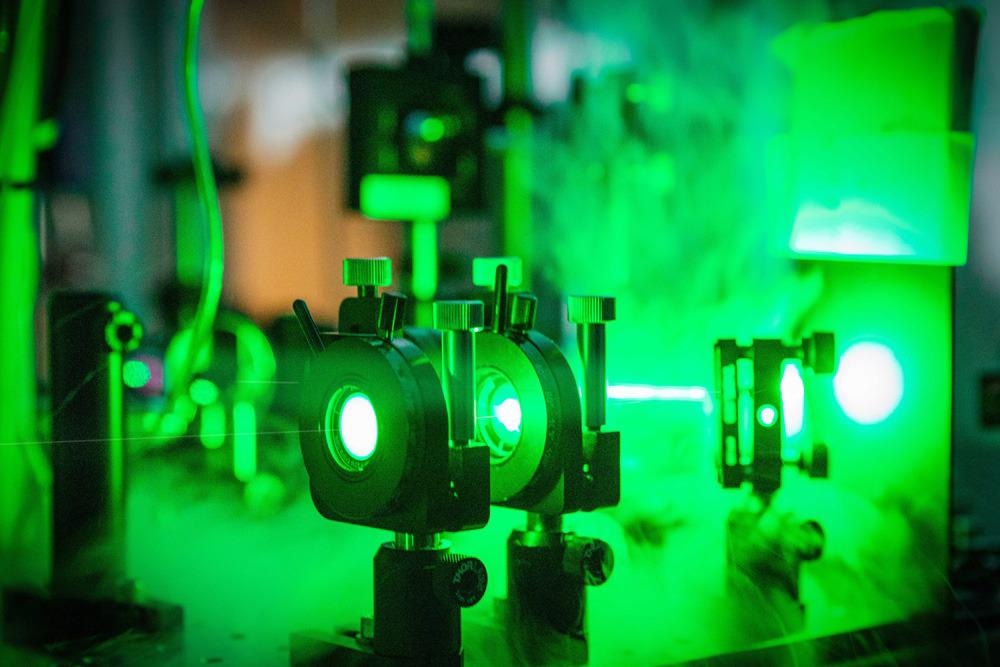Reviewed by Alex SmithSep 24 2021
Particle accelerators are important tools in research areas such as materials science, biology and particle physics. Scientists are continually seeking stronger ways of accelerating particles to enhance existing equipment and boost capacities for experiments.
 Experimental setup in the laser laboratory. Image Credit: Maximilian Schlosser.
Experimental setup in the laser laboratory. Image Credit: Maximilian Schlosser.
The dielectric laser acceleration (DLA) is one such robust technology. In this method, the acceleration of particles is carried out in the optical near-field. This occurs when ultra-short laser pulses are concentrated on a nanophotonic structure.
Using this technique, scientists from the Chair of Laser Physics at Friedrich-Alexander-Universität Erlangen-Nürnberg (FAU) have been successful in guiding electrons via a vacuum channel, a crucial component of particle accelerators.
The general design of the photonic nanostructure channel was developed by research partners at TU Darmstadt. They have recently reported their combined findings in the Nature journal.
Staying Focused
As charged particles are inclined to move far away from each other as they disperse, all accelerator technologies have to handle the challenge of keeping the particles within the necessary time and spatial boundaries. Consequently, particle accelerators can be up to 10 km in length and require years of preparation and building before they can be used, besides the huge investments involved.
DLA uses ultra-fast laser technology and progresses in semi-conductor production to potentially reduce these accelerators to just a few millimeters or centimeters in size.
A promising method: Experiments have already shown that DLA surpasses presently used technologies by a minimum of 35 times. This means that the length of a prospective accelerator could be minimized by the same factor. Thus far, however, it was obscure whether these figures could be extended to longer and longer structures.
A team of physicists headed by Prof. Dr. Peter Hommelhoff from the Chair of Laser Physics at FAU has taken a huge step forward toward adapting DLA for application in completely functional accelerators. Their experiment is the first to create a scheme that can be used to direct electron pulses over long distances.
Technology is Key
The system, known as “alternating phase focusing” (APF) is a technique taken from the initial days of accelerator theory. A fundamental law of physics means that concentrating charged particles in all three dimensions simultaneously — height, width and depth — is not possible.
Yet, this can be overcome by interchangeably focusing the electrons in different dimensions. To begin with, electrons are focused using a modulated laser beam, then they “drift” via another short passage where no forces impact them before they are accelerated at the end, which allows them to be directed forward.
In their experiment, the researchers from FAU and TU Darmstadt combined a colonnade of oval pillars with short gaps at steady intervals, giving rise to repeated macro cells. Each macro cell either has a focusing or defocusing influence on the particles, based on the delay among the electron, the incident laser, and the gap which forms the drifting section.
This arrangement allows exact electron phase space control at the optical or femto-second ultra-timescale (a femto-second matches a millionth of a billionth of a second).
In the present experiment, shining a laser on the structure reveals an increase in the beam current via the structure. If a laser is not used, the electrons cannot be guided and slowly crash into the channel’s walls.
It’s very exciting. By way of comparison, the large Hadron collider at CERN uses 23 of these cells in a 2450 metre long curve. Our nanostructure uses five similar-acting cells in just 80 micrometres.
Johannes Illmer, Study Co-Author and Physicist, FAU
When Can the First DLA Accelerator be Expected?
The results are extremely significant, but for us, it is really just an interim step. And our final goal is clear: we want to create a fully-functional accelerator — on a microchip.
Dr. Roy Shiloh, Chair for Laser Physics, FAU
The researchers have reported their results in Nature. The study received financial assistance from the Gordon and Betty Moore Foundation (#GBMF4744), the ERC projects NearFieldAtto (#616823) and AccelOnChip (#884217), and the BMBF projects 05K19WEB and 05K19RDE.
Journal Reference:
Shiloh, R., et al. (2021) Electron phase-space control in photonic chip-based particle acceleration. Nature. doi.org/10.1038/s41586-021-03812-9.